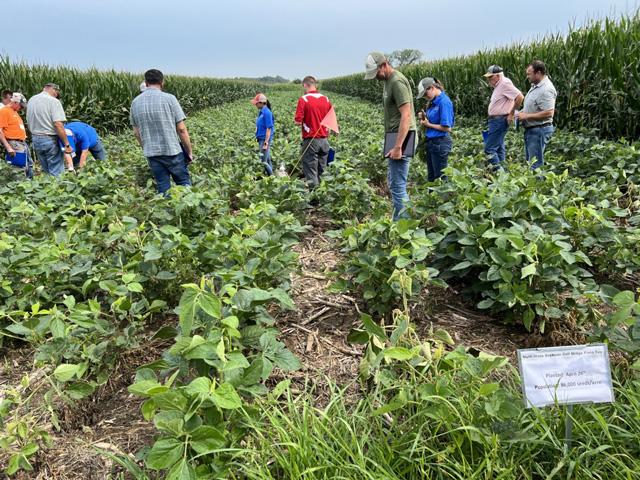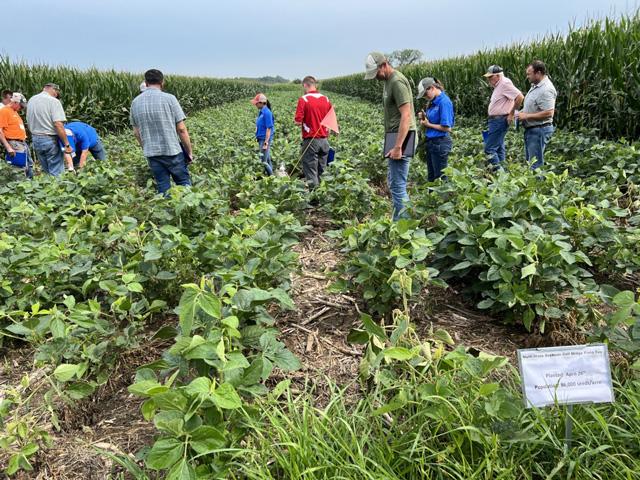Production Blog
Four Things to Know About Soybean Gall Midge
Entomologists officially began mapping soybean gall midge (SGM) as a pest in 2018. Since then, SGM has continued to spread along the Missouri River Valley and beyond. There have been 158 counties in six states documented as infested as of June 27, 2023.
My family grows soybeans, along with corn and forages, in eastern Nebraska. I knew the pest was aggressive and damaging, but I didn't really know that much about it until I attended the 2023 Multi-State Soybean Gall Midge Field Day held at the University of Nebraska Eastern Nebraska Research, Extension and Education Center near Mead, Nebraska, on July 25.
Extension entomologists from the University of Nebraska-Lincoln (UNL), Iowa State University, Kansas State University and the University of Minnesota presented information about SGM.
Here are four things I learned about the pest:
1. No one knows where SGM came from.
Justin McMechan, UNL Extension crop protection and cropping systems specialist, said entomologists are not exactly sure where the pest came from. Midges are found in this region, but no one fully understands what happened to cause the pest to begin to feed on soybeans.
Plants found in the area, such as sweet clover, are natural hosts for the pest. At some point, something changed, and the pest began to feed on soybeans plants, he said.
"You can find them on sweet clover plants easier than you can on soybean plants," McMechan told the field day attendees.
Erin Hodgson, Iowa State University Extension entomologist, told DTN researchers believe a natural host for SGM would be leadplant. This plant is native to the Missouri River Valley and might help to explain why the pest has started in the area and spread outward, especially north and south. Read more about the plant here: https://plants.usda.gov/….
"But we really don't know for sure," Hodgson told DTN.
Watch a video interview with Hodgson here: https://www.dtnpf.com/….
P[L1] D[0x0] M[300x250] OOP[F] ADUNIT[] T[]
2. The damage from SGM can be devastating.
We walked into plots of soybeans and split stems to observe damage. Within some stems, we found the tiny, white and orange SGM larvae.
The damage I saw wasn't evident until I was in the plot. Green plants look fairly normal, until they were touched. They were extremely brittle. Later in the season, infested plants wither and die.
Jack Nagel, a Davey, Nebraska, farmer said that a few years ago, his soybean fields were severely affected by SGM. He and his son, Doug, farm both corn and soybeans in Lancaster and Saunders counties in east-central Nebraska.
"We have a 35-foot grain platform, and at harvest, our grain monitor only showed a yield a few bushels in the first five or six swaths around that one field," Nagel told DTN. "They were terrible around the field edges."
Nagel said they have tried to work with their neighbors to plant their soybean acres together to avoid corn and soybeans bordering each other. Gall midge tends to be more severe in soybean fields that are adjacent to a field that had an infestation the previous year.
While they still have SGM present in their fields, it has never been as a bad as it was that first year, Nagel said.
3. Land-grant universities are doing a lot of research on SGM.
University Extension in Nebraska, Iowa, Kansas, Minnesota and the Dakotas is doing extensive research to better understand the pest and find ways to limit the damage from SGM.
At UNL's research farm near Mead, many different research plots can be found. Researchers are looking to see if there are soybean varieties that withstand the pest, planting dates and even hilling soil around soybean plants by mechanical cultivation to protect the base of plants where the pests feed.
Some farmers expressed their reluctance about the thought of cultivating soybean crops again.
4. Research into biological control of SGM is ongoing.
Researchers from the University of Minnesota have done studies to see if there are natural predators that could feed on SGM. University of Minnesota Extension Soybean entomologist Robert Koch and Sarah Lisak, a master's student at the University of Minnesota, presented research on this subject.
They are researching if the common ground beetle could eat SGM in soybean fields. Results are still early, but they have found the DNA of SGM in the gut of common ground beetles.
"The question is if we can see the beetles eating a higher percentage of SGM DNA," Lisk said.
Answers can't come soon enough for Nebraska soybeans producers like Nagel. "This has really become a big pain for us in recent years," he said.
Want to learn more about this pest? The Soybean Gall Midge Alert Network provides timely updates on emergence. It's also the hub for new management information and videos on how to scout for the pest. Go to: https://soybeangallmidge.org/….
For more DTN writing on this topic go to: https://www.dtnpf.com/…
Russ Quinn can be reached at Russ.Quinn@dtn.com
Follow him on Twitter @RussQuinnDTN
(c) Copyright 2023 DTN, LLC. All rights reserved.





Comments
To comment, please Log In or Join our Community .